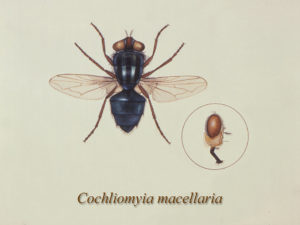 Two serious diseases (one in people and one in animals) transmitted by insects have been totally eliminated from specific locations. Such news would be noteworthy in any season. During this environmentally troubled holiday period especially it merits celebrating and sharing with friends, relatives and colleagues in the year ahead. Why? Because the methods used in each case involved science-based strategies that minimized or removed reliance on toxic chemical pesticides. These successful programs (one in Sri Lanka, one in the U.S.) have benefitted human and animal health as well as the environment. Details are found below in two sections (A & B).
Two serious diseases (one in people and one in animals) transmitted by insects have been totally eliminated from specific locations. Such news would be noteworthy in any season. During this environmentally troubled holiday period especially it merits celebrating and sharing with friends, relatives and colleagues in the year ahead. Why? Because the methods used in each case involved science-based strategies that minimized or removed reliance on toxic chemical pesticides. These successful programs (one in Sri Lanka, one in the U.S.) have benefitted human and animal health as well as the environment. Details are found below in two sections (A & B).
(A ) From Sri Lanka
 In the past, control of malaria has been associated with widespread use of hazardous insecticides (DDT and others) in order to reduce levels of the mosquito population capable of transmitting the malaria parasite from infected to uninfected people. From the island nation of Sri Lanka comes the success story of the total elimination of malaria, using a science-based, government supported strategy.
In the past, control of malaria has been associated with widespread use of hazardous insecticides (DDT and others) in order to reduce levels of the mosquito population capable of transmitting the malaria parasite from infected to uninfected people. From the island nation of Sri Lanka comes the success story of the total elimination of malaria, using a science-based, government supported strategy.
In 2016 Sri Lanka announced the elimination of malaria (no new endemic cases found during the prior 3 years) due to a program that did not involve widespread broadcast spraying of chemical insecticides to control mosquitoes. Rather, the government-backed effort focused (especially in children) on a combination of rapid diagnosis of the disease followed by effective drug therapy to control malaria infections, thereby effectively halting the future transmission of the malaria parasite to other people through mosquito vectors.
This strategy was combined with the use of: bed nets, insecticide spraying indoors, and other, on-site mosquito preventive measures. This was part of a strong, country-wide political commitment – involving teamwork, public education and an enlightened public health system – focused on the goal of successfully eliminating malaria from the island nation. (Bosley, S., Beginning of End for Malaria?” Guardian Weekly, 9-16-16)( “SEARO’s Battle Against Malaria: Sri Lanka and Bhutan Show the Way,” World Health Organization) Sri Lanka’s triumphant strategy shows the effectiveness of a more sustainable approach to eliminating malaria than previous reliance on the use of massive quantities of drugs and insecticides – until over time the eventual development of resistance to the agents (by the malaria parasite and the mosquito vector) could render these chemical controls ineffective and they too would need to be replaced by newer combinations of drugs and pesticides. For example, DDT used in Sri Lanka in the early 1960s for mosquito vector control brought down the level of malaria in the population, but did not eliminate it. Eventually the target mosquitoes became resistant to DDT and the number of malaria cases flared. DDT was replaced by the organophosphate insecticide malathion, to which resident mosquitoes were then susceptible.
(B) From the U. S.
Recently, the state of Florida provided an example of a still-effective, non-chemical method developed in the 1950s against a dangerous disorder caused by infestations of the screw-worm fly, an insect that can attack livestock, domestic animals and wildlife. In 2017 a recently-found infestation of the screw-worm fly was eliminated from the state of Florida.
While the most recent chapter in this story takes place in Florida during 2017, the backstory began in Silent Spring’s last chapter (“The Other Road”) where Rachel Carson described a then newly-developed non-chemical strategy for controlling a horrendously nasty disease afflicting animals both domestic and wild due to infestations by the screw-worm fly, found at that time in the South, Southwest and Midwest. As described by Carson, “The [screw-worm fly] females…lay their eggs in any open wound of a warm-blooded animal. The hatching larvae are parasitic feeding on the flesh of the host. A full-grown steer may succumb to a heavy infestation in 10 days, and livestock losses in the United States have been estimated at $40,000,000 a year…This subtropical insect inhabiting Mexico…is normally restricted to the Southwest. About 1933 it was accidentally introduced into Florida…” (Silent Spring, p. 280-281) A method developed against this destructive insect during the 1950s at the USDA consisted of sterilizing, by radiation, laboratory-raised male screw-worm flies and releasing them to mate with normal wild females. Note: Releasing sterile males is effective in eradicating screw-worm flies because each female mates only one time. A successful initial trial on the island of Curacao found that the sterile male screw-worm flies produced infertile eggs only 7 weeks after their release from planes. (Silent Spring, p. 280-281)
Here is the update to Silent Spring’s information. Using the sterile male method, the U.S. eradicated its self-sustaining screwworm populations by 1966. (JAVMA, October 1, 2017) Today the U.S. and Panama maintain a sterile fly barrier at the Columbia border, keeping the screw-worm flies from spreading northward from South America.
However, in October 2016 the USDA confirmed the presence of screw-worm fly disease again in Florida, but this time in the Keys among the Key Deer, an endangered population. (The origin of the recent Florida infestation remains to be determined). Releasing about 190 million radiation-treated, sterile male flies and conducting public education and follow-up inspections at a cost of over $5 million, resulted in the screwworm fly infestation being eradicated from Florida in March 2017 six months after it was diagnosed in the Key Deer population. (JAVMA, October 1, 2017)
Carson described the successful reduction of the screw-worm fly population through the use of radiation to create sterile males as “a triumphant demonstration of the worth of scientific creativity, aided by thorough basic research, persistence and determination.”(Silent Spring, p. 280-281)
Future Needs for Pest Elimination in View of a Warming Planet
Our nation and indeed the countries of the world need to support a scientific approach aimed at developing alternative methods – that work with nature –and are effective at eliminating pests from specific areas without broadcast spraying of toxic chemical pesticides.
Future strategies will need to rely on greater use of scientific research about the pest, along with more public education, and a stronger commitment by public health departments and governments to replace widespread chemical applications with a more diverse approach (as was done by the island nation of Sri Lanka). Future pest management should include working with nature and the life cycle of the pest (as was done in the U.S. with the screwworm fly eradication).
 In returning to Carson’s words written over 55 years ago, we need more strategies for pest elimination that can be celebrated as “triumphant demonstrations of the worth of scientific creativity, aided by thorough basic research, persistence and determination.” (Silent Spring, p. 280-281)
In returning to Carson’s words written over 55 years ago, we need more strategies for pest elimination that can be celebrated as “triumphant demonstrations of the worth of scientific creativity, aided by thorough basic research, persistence and determination.” (Silent Spring, p. 280-281)
We believe that qualities described by Carson still exist (in present-day scientists and administrators). We hope that a greater focus on ecological pest management successes can help convince scientists, universities, research facilities and pest control organizations to decrease their reliance on the widespread use of toxic chemicals and turn their attention to innovative approaches that do not poison ourselves or sicken our world.
Diana Post and Munro Meyersburg
12-8-17





